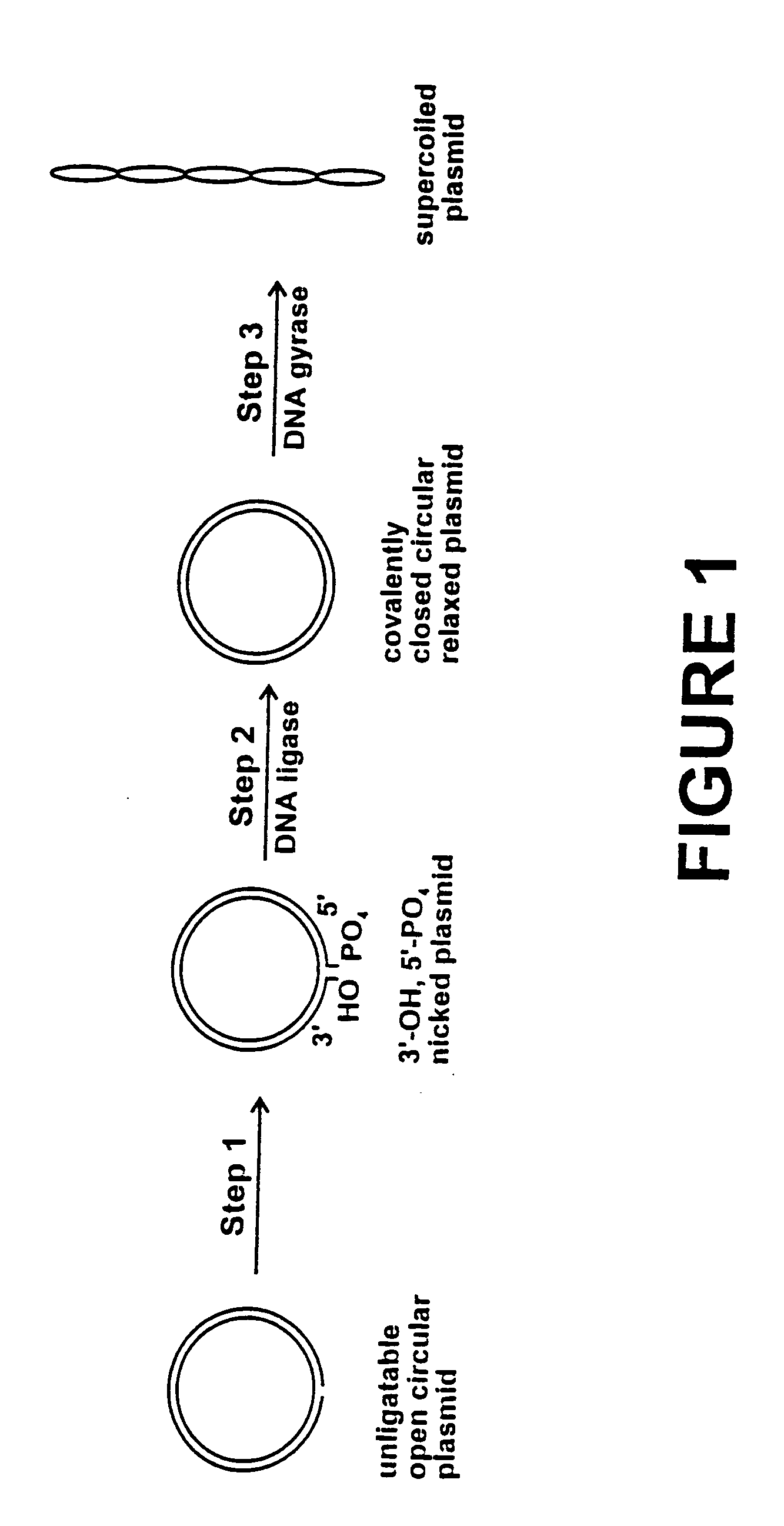Method for plasmid preparation by conversion of open circular plasmid to supercoiled plasmid
- Summary
- Abstract
- Description
- Claims
- Application Information
AI Technical Summary
Benefits of technology
Problems solved by technology
Method used
Image
Examples
example 1
Preferred Mode
[0132] A 10 μl reaction volume contained 5 μg p4 kb plasmid, 35 mM Tris-HCl (pH 7.5), 25 mM KCl, 4 mM MgCl2, 2 mM dithiothreitol, 1.8 mM spermidine, 1 mM ATP, 6.4% glycerol, 0.1 mg / ml bovine serum albumin, 2.5 units DNA gyrase, 2.8 μg GST-T4 DNA ligase, 0.2 units DNA polymerase 1,200 μM dATP, 200 μM dGTP, 200 μM dCTP, and 200 μM dTTP. This reaction was incubated at 37° C. for 2 hours. After incubation, the plasmid was analyzed by agarose gel electrophoresis. The gel showed a high yield of supercoiled plasmid, confirming conversion of most of the open circular plasmid to supercoiled plasmid. By visual inspection of the stained gel, it is estimated that about 80% to 85% of open circular plasmid was converted to supercoiled form. Based on flourometry analysis, the total amount of plasmid measured before and after the reaction was the same. Extending the incubation time to 4 hours resulted in about 95% conversion. A 2-hour incubation using 1 μg p4 kb resulted in about 95%...
example 2
Preferred Mode+3′ Deblocking Enzyme
[0133] A 10 μl reaction volume contained 5 μg p4 kb plasmid, 35 mM Tris-HCl (pH 7.5), 25 mM KCl, 4 mM MgCl2, 2 mM dithiothreitol, 1.8 mM spermidine, 1 mM ATP, 6.4% glycerol, 0.1 mg / ml bovine serum albumin, 2.5 units DNA gyrase, 2.8 μg GST-T4 DNA ligase, 0.2 units DNA polymerase I, 200 μM dATP, 200 μM dGTP, 200 μM dCTP, 200 μM dTTP, and 0.5 units exonuclease III. This reaction was incubated at 37° C. for 2 hours. After incubation, the plasmid was analyzed by agarose gel electrophoresis. The gel showed high purity supercoiled plasmid, confirming conversion of virtually all of the open circular plasmid to supercoiled plasmid. The open circular band was barely visible on the gel. By visual inspection of the stained gel, it is estimated that greater than about 95% to 99% of open circular plasmid was converted to supercoiled form. Based on flourometry, the total amount of plasmid measured before and after the reaction was the same. A 4-hour incubation u...
example 3
Preferred Mode+ATP Regeneration
[0134] A 10 μl reaction volume contained 5 μg p4 kb plasmid, 35 mM Tris-HCl (pH 7.5), 25 mM KCl, 4 mM MgCl2, 2 mM dithiothreitol, 1.8 mM spermidine, 1 mM ATP, 6.4% glycerol, 0.1 mg / ml bovine serum albumin, 2.5 units DNA gyrase, 2.8 μg GST-T4 DNA ligase, 0.2 units DNA polymerase 1,200 μM dATP, 200 μM dGTP, 200 μM dCTP, 200 μM dTTP, 0.05 units creatine kinase (Sigma C3755), and 1 mM creatine phosphate. This reaction was incubated at 37° C. for 2 hours. After incubation, the plasmid was analyzed by agarose gel electrophoresis. The gel showed high purity supercoiled plasmid, confirming conversion of most of the open circular plasmid to supercoiled plasmid. By visual inspection of the stained gel, it is estimated that about 75% to 80% of open circular plasmid was converted to supercoiled form.
PUM
| Property | Measurement | Unit |
|---|---|---|
| Fraction | aaaaa | aaaaa |
| Fraction | aaaaa | aaaaa |
| Energy | aaaaa | aaaaa |
Abstract
Description
Claims
Application Information
 Login to View More
Login to View More - R&D
- Intellectual Property
- Life Sciences
- Materials
- Tech Scout
- Unparalleled Data Quality
- Higher Quality Content
- 60% Fewer Hallucinations
Browse by: Latest US Patents, China's latest patents, Technical Efficacy Thesaurus, Application Domain, Technology Topic, Popular Technical Reports.
© 2025 PatSnap. All rights reserved.Legal|Privacy policy|Modern Slavery Act Transparency Statement|Sitemap|About US| Contact US: help@patsnap.com

